Alabama is home to eight species of woodpeckers, including the familiar red-bellied and downy woodpeckers, the northern flicker – Alabama’s state bird, the huge pileated and striking red-headed, the uncommon hairy woodpecker, the rare red-cockaded, and the yellow-bellied sapsucker that visits the state only in winter. They occur in forests, parks, and wooded neighborhoods across the state, with particularly good viewing in Bankhead, Talladega, and Conecuh National Forests, Wheeler National Wildlife Refuge, and the Mobile-Tensaw Delta.
This ID guide introduces all of the woodpecker species regularly found in Alabama, outlining how to identify them, where they occur in the state, and the habitats and seasons in which they are most easily observed. Each account combines practical spotting tips with state-specific range notes to help both new and experienced birders recognize these birds.
Red-Bellied Woodpecker
Melanerpes carolinus
- Identification: Medium-sized, pale woodpecker with a boldly barred black-and-white back and red crown and nape in males (only the nape red in females); the faint reddish wash on the belly is often hidden.
- Where found: Common year-round across all regions of Alabama, frequent in forests, woodlots, pine-hardwood mixes, swamps, and urban and suburban areas.
- How to spot: Look for a pale-faced woodpecker with a “zebra” back and bright red cap moving along trunks and branches; listen for rolling “kwirr” or “churr” calls carrying through woodlands and neighborhoods.
- Conservation status: Least Concern (IUCN); population stable to increasing in Alabama, with expanding presence in human-modified habitats.
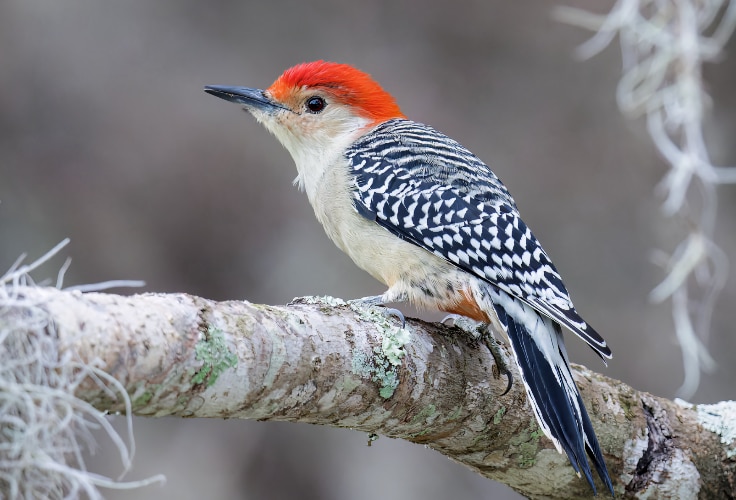
The red-bellied woodpecker is Alabama’s most widespread and familiar woodpecker, present in nearly every wooded landscape from the Tennessee Valley to the Gulf Coast. Measuring 23 to 27 centimeters (9.1 to 10.6 inches) long, it is slender and pale-faced, with a strongly barred back that flashes in flight. The reddish patch on the lower belly rarely shows, but the bright red crown and nape of males, or the red nape of females, make the species easy to recognize once its “zebra” back is seen.
Adults are patterned in crisp black and white across the wings, tail, and back, with grayish underparts and a pale face. A white rump and white patches near the wingtips are conspicuous in flight. Birds move with quick, hitching steps along trunks and branches, often pausing to probe bark for insects or to pick up acorns, nuts, or berries. Their rolling “kwirr” or “churr” calls are signature sounds of Alabama woodlands, and they frequently give sharp notes or short drumming bursts, especially in spring.

This species occupies nearly every wooded habitat in Alabama, thriving in mature hardwoods, pine-oak stands, mixed forests, river bottoms, and cypress-tupelo swamps. It is equally comfortable in towns and suburbs, where it nests in dead limbs, utility poles, and old fence posts. It is one of the state’s most adaptable woodpeckers, and its abundance is highest across the coastal plain, where forest cover and hardwood food sources are extensive. Birds remain in Alabama year-round, and activity is steady in all seasons, with increased vocalizing and drumming from late winter through spring.
Red-bellied woodpeckers interact with several cavity-nesting species in the state. They occasionally compete with the federally listed red-cockaded woodpecker by taking over its cavities in living pines, which can pose a challenge for small or isolated populations. They also defend their own nest sites vigorously and may displace smaller species such as downy woodpeckers. Despite these aggressive interactions, the species remains a stable and successful breeder statewide. Human-altered landscapes have benefited this woodpecker, and it continues to increase across much of its range, making it a reliable sight from backyard feeders to remote forests throughout Alabama.
Downy Woodpecker
Dryobates pubescens
- Identification: Small black-and-white woodpecker with a broad white back stripe, checkered wings, and a small red nape patch in males; bill short and stubby.
- Where found: Common year-round throughout Alabama in open deciduous woods, riparian groves, mixed forests, orchards, parks, and residential areas.
- How to spot: Listen for the sharp “pik” call or descending whinny; watch for a tiny black-and-white bird moving along thin branches or visiting suet feeders.
- Conservation status: Least Concern (IUCN); population stable in Alabama, benefiting from open woodlands and human-modified habitats.

The downy woodpecker is Alabama’s smallest woodpecker and one of the state’s most familiar, appearing in nearly any setting where trees or shrubs are present. Measuring 14 to 17 centimeters (5.5 to 6.7 inches) in length, it shows the classic straight-backed woodpecker posture but in a compact form, with a short, chisel-like bill that is noticeably smaller than that of the similar hairy woodpecker. Its small size and adaptability make it a frequent sight in forests, neighborhoods, and backyard feeding stations.
Adults display a clean black-and-white pattern with a broad white stripe down the back, spotted wings, and sharp facial striping. Males have a small red nape patch, while females lack red entirely. Birds move with short hops along trunks and branches, often shifting to thin twigs or hanging from seed heads where they extract insects. Their sharp “pik” call and descending whinny are common sounds in Alabama woodlands, and in winter they often join mixed flocks of chickadees, titmice, and nuthatches.
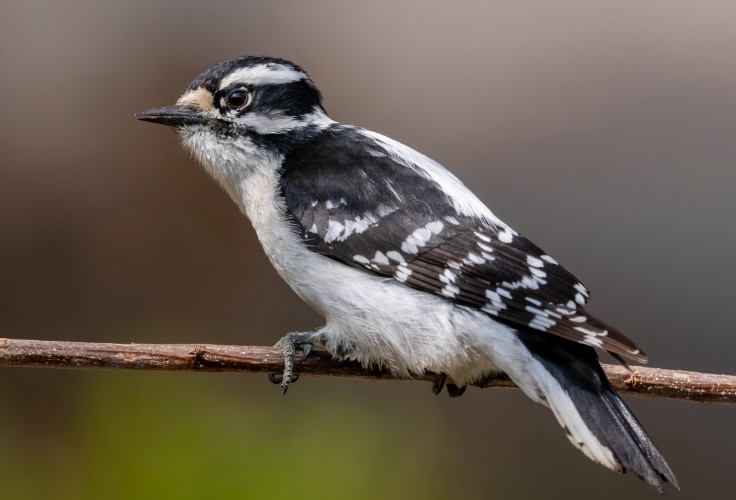
Across Alabama, downy woodpeckers occupy a wide range of habitats. They are common in open deciduous woodlands, willow stands, river groves, mixed forests, and forest edges, especially where dead limbs provide foraging sites and excavation opportunities. They adapt well to orchards, parks, and suburban areas, readily nesting in dead branches and fence posts. Backyard bird feeders offering suet or peanuts attract them throughout the year, making them a regular visitor in both urban and rural settings.
Downy woodpeckers remain abundant in Alabama, with no indication of decline. Their ability to use lightly wooded areas and human-altered landscapes supports stable numbers across all regions. Although the loss of dead wood can locally reduce nest sites, the species continues to thrive statewide, active in every season and easy to observe wherever small patches of trees or shrubs occur.
Northern Flicker
Colaptes auratus
- Identification: Large brownish woodpecker with a barred back, spotted underparts, black breast crescent, and bright yellow flight feather shafts; white rump flashes clearly in flight.
- Where found: Year-round throughout Alabama, especially in open woodlands, forest edges, groves with scattered dead trees, parks, towns, and larger yards; most abundant in winter when northern birds join resident populations.
- How to spot: Look for a woodpecker feeding on the ground or rising in an undulating flight that reveals a bright flash of yellow under the wings and a white rump; listen for loud “wick-wick-wick” calls or sharp “peah” notes.
- Conservation status: Least Concern (IUCN); in Alabama, populations generally stable, though modest regional declines occur where dead trees are scarce.

The northern flicker is Alabama’s most recognized and culturally significant woodpecker, known locally as the “yellowhammer” and honored as the official state bird. Measuring 28 to 31 centimeters (11.0 to 12.2 inches) long, it is a sleek, brownish woodpecker with barred upperparts, spotted underparts, and a bold black crescent across the breast. Only the yellow-shafted form occurs in Alabama, making the flash of bright yellow under the wings and tail one of the species’ most distinctive traits. A white rump stands out whenever the bird takes flight.
Adults show fine brown, black, and gray patterns that blend well with woodland edges. Males have a black mustache stripe on the face, while females lack it. In flight, the combination of yellow underwings and a flaring white rump is diagnostic. Flickers call loudly, especially in spring, giving ringing “wick-wick-wick” notes, sharp “peah” calls, and rhythmic drumming on resonant surfaces. Unlike most other woodpeckers in the state, they spend much of their foraging time on the ground, probing soil and anthills for ants and beetles using a long, barbed tongue adapted for extracting prey.

In Alabama, northern flickers occur statewide and in all seasons, though numbers rise noticeably in winter when migrants from the northern states and Canada join local birds. They inhabit open woodlands, pine-oak ridges, river groves, forest edges, pastures with scattered trees, and suburban parks. Dead limbs and snags are essential for nest excavation, but flickers also use old wooden utility poles and occasionally buildings or fence posts. They often appear in residential areas, where they visit suet feeders and forage in lawns for ants.
The species breeds sparingly in Alabama compared to its winter density, with most resident pairs nesting between March and June. Drumming becomes frequent in late winter as males advertise territories and court mates. Nest cavities are excavated in dead wood, and both adults share incubation and care of the young. After the breeding season, abandoned cavities provide nest sites for bluebirds, chickadees, and small mammals.
Northern flickers remain generally stable across Alabama, though they are sensitive to the loss of dead trees used for nesting. Competition with European starlings for cavities can affect local breeding success, yet the species maintains a strong statewide presence. Its reliance on both open ground and standing dead wood makes it a characteristic bird of Alabama’s mixed landscapes, from rural pasture edges to city parks, its bright flashes of yellow and distinctive calls marking its place as the state’s enduring “yellowhammer.”
Pileated Woodpecker
Dryocopus pileatus
- Identification: Very large black woodpecker with bold white neck stripes and a flaming red crest; males have a red mustache stripe, females a dark one; shows broad white underwings and a flashing white patch in flight.
- Where found: Year-round throughout Alabama in mature deciduous, coniferous, and mixed forests with large trees and standing dead wood.
- How to spot: Look for a crow-sized black woodpecker with a tall red crest chiseling deep rectangular holes in trunks; listen for loud “kuk-kuk-kuk” calls or slow, resonant drumming.
- Conservation status: Least Concern (IUCN); stable in Alabama, supported by extensive forest cover and the availability of large snags.

The pileated woodpecker is Alabama’s largest woodpecker and a striking presence in mature forests across the state. Measuring 40 to 49 centimeters (15.7 to 19.3 inches) long, it is instantly recognizable by its broad wings, long neck, and vivid red crest. The mostly black plumage is broken by white stripes along the neck, and in flight, broad white underwing patches show clearly. Males have a red mustache stripe that females lack.
These birds move with strong, deliberate hops along trunks and logs, using long chisel-like bills to excavate deep, rectangular holes in decaying wood. Their loud “kuk-kuk-kuk” calls carry over long distances, and their drumming is powerful and slow, often tapering at the end. Most feeding occurs on fallen logs or standing snags where carpenter ants and beetle larvae are abundant, supplemented by seasonal fruits and nuts.

Across Alabama, pileated woodpeckers inhabit extensive forests of many types, especially mature hardwood stands, mixed pine-oak ridges, and bottomland woods. They occur statewide throughout the year, with highest activity noted in late winter and spring when birds drum frequently and move through territories with regular, looping flights. Although most common in large forest tracts, they can also appear in younger stands that retain some large trees or downed timber.
The species remains stable in Alabama, supported by widespread forest cover and the continued presence of standing dead wood for nesting and roosting. Its large cavities later benefit other wildlife, including owls, ducks, and bats. As long as mature forests and decaying trees persist, the pileated woodpecker will remain a familiar and impressive resident of Alabama’s woodlands.
Red-Headed Woodpecker
Melanerpes erythrocephalus
- Identification: Medium-sized woodpecker with a fully crimson head, black back, large white wing patches, and clean white underparts.
- Where found: Widespread across Alabama in spring, summer, and fall, and less common in winter; favors open woodlands, savannas, riparian groves, orchards, farmlands, and suburban areas with standing dead trees.
- How to spot: Look for bold black-and-white wings flashing in steady flight and a solid red head; listen for harsh “weah” calls; often seen perching on snags or catching insects on the wing.
- Conservation status: Least Concern (IUCN); in Alabama, moderate conservation concern due to habitat loss and dependence on snag-rich, open forest conditions.

The red-headed woodpecker is one of Alabama’s most striking birds, instantly recognized by its uniform crimson head and sharp black-and-white plumage. Measuring 19 to 24 centimeters (7.5 to 9.4 inches) long, it has a sturdy build, broad wings, and a powerful, straight bill. Adults show large white wing patches that form bright squares in flight, while juveniles are brownish on the head until they molt into full adult colors.
In the field, this species behaves differently from most Alabama woodpeckers. It often perches openly on snags, fence posts, and utility poles, darting out to capture flying insects in midair. It also forages on the ground and caches nuts and fruit in tree crevices. Its calls are sharp, rolling “weah” or “churr” notes, and its flight is direct and steady rather than bounding. Because it relies heavily on open structure, scattered dead trees, and seasonal nut crops, red-headed woodpeckers are most easily found in areas where these features remain intact.

Across Alabama, the species occupies a wide variety of open or semi-open habitats – oak and pine savannas, recently cut forests with retained snags, riparian corridors, orchards, agricultural edges, and suburban areas with large trees. It is fairly common from spring through fall across all regions and becomes less common in winter when some individuals depart the state and northern birds arrive in variable numbers. Local movements can be complex, with some birds shifting north or south depending on annual acorn availability and weather.
Although still widespread, the red-headed woodpecker depends on landscapes containing standing dead trees and open understories, features that have declined in many parts of its range. In Alabama, populations remain stable in well-managed open forests, post-fire areas, and places where snags are preserved. Maintaining these conditions is essential for sustaining the species’ presence, ensuring that the bright flash of a red-headed woodpecker remains a familiar sight in Alabama’s open woodlands.
Hairy Woodpecker
Leuconotopicus villosus
- Identification: Medium-sized black-and-white woodpecker with a broad white back stripe, clean white underparts, and a long, sturdy bill nearly as long as the head; males show a red patch on the nape.
- Where found: Uncommon year-round across Alabama in pine, hardwood, and mixed forests, most often in larger or less fragmented woodland tracts.
- How to spot: Search main trunks and large limbs for a boldly patterned black-and-white bird with a square head and long bill; listen for its loud “peek” call, lower-pitched whinny, or steady drumming.
- Conservation status: Least Concern (IUCN); stable in Alabama, though limited by availability of extensive forested habitat.
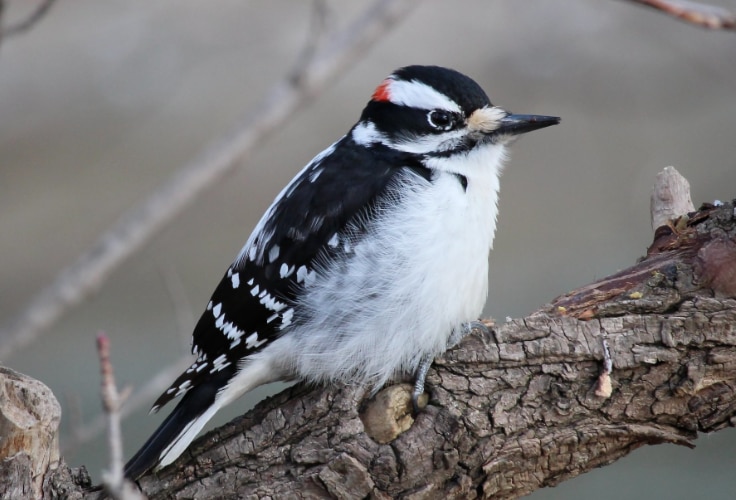
The hairy woodpecker is an uncommon but regular resident in Alabama’s forests, appearing noticeably larger and longer-billed than the similar downy woodpecker. Measuring 18 to 26 centimeters (7.1 to 10.2 inches) long, it has a sturdy, upright build and a long chisel-like bill that gives it a more robust look than its smaller relative. A wide white stripe down the back contrasts with spotted black wings and a boldly striped face, and males show a small red patch on the nape.
In the field, hairy woodpeckers concentrate their activity on main trunks and larger limbs, climbing with steady, deliberate hops and frequently striking the bark with strong blows. They tend to avoid the thin branches favored by downy woodpeckers, a distinction that often helps with identification. Their calls include a sharp, powerful “peek” and a descending whinny, and their drumming is firm and even. They feed on wood-boring insects and larvae, along with fruit and seeds, and will visit suet feeders where forests border neighborhoods or rural yards.

In Alabama, hairy woodpeckers occur statewide but at low densities, with most records coming from pine and mixed woodlands, mature hardwood tracts, forested slopes, and river corridors. They are generally more frequent in larger or less fragmented forests, where dead limbs and snags provide reliable foraging and nesting opportunities. Activity is consistent year-round, though birds may be easier to detect in late winter and early spring when drumming becomes more frequent.
Although uncommon, the species remains stable in Alabama, supported by the presence of older forests and retained dead wood. Its rarity compared to the widespread downy woodpecker reflects habitat preferences rather than population decline. Where extensive forest cover persists, the hairy woodpecker continues to maintain a quiet but steady presence in the state’s woodlands.
Yellow-Bellied Sapsucker
Sphyrapicus varius
- Identification: Small to medium black-and-white woodpecker with a red crown, red throat in males (white in females), pale yellowish underparts, and a large white wing patch.
- Where found: A winter visitor across Alabama from fall through early spring, occurring in open forests, orchards, forest edges, parks, and residential areas.
- How to spot: Look for neat horizontal rows of sap wells on tree trunks or a quietly perched bird with a red crown; listen for soft nasal “mew” calls, though the species is usually silent in winter.
- Conservation status: Least Concern (IUCN); stable in Alabama as a regular migrant and wintering species.
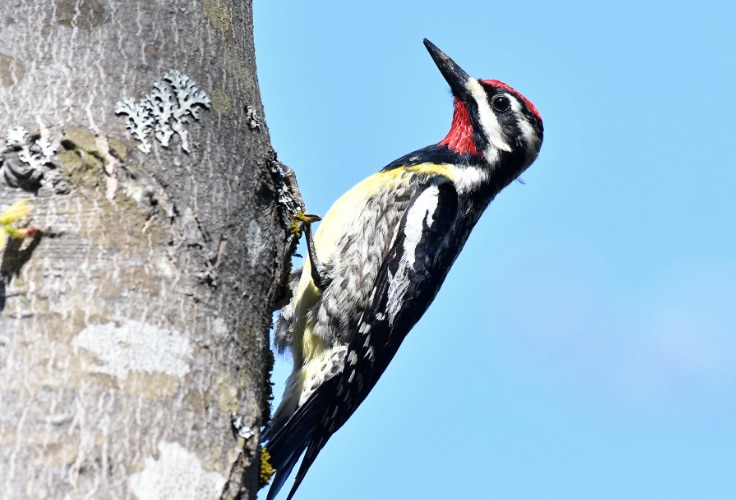
The yellow-bellied sapsucker is the only fully migratory woodpecker to visit Alabama, appearing from mid-fall through spring before moving north to its breeding grounds in Canada and the northern United States. Measuring 18 to 22 centimeters (7.1 to 8.7 inches) long, it is slender and cleanly patterned, with a straight, pointed bill, crisp black-and-white facial striping, and a pale wash of yellow across the belly. Males show a red throat, while females have a white one, and both sexes display a bright red crown.
In Alabama, sapsuckers often remain still for long stretches as they maintain neatly spaced rows of sap wells on tree trunks. They favor birch, maple, and fruit trees but will use many species in winter, including those found in urban parks and yards. When active, they hitch quietly along trunks or make short flights to catch insects. Their nasal “mew” and soft tapping are characteristic in other seasons, but in Alabama they are usually silent, making their sap wells one of the best clues to their presence.
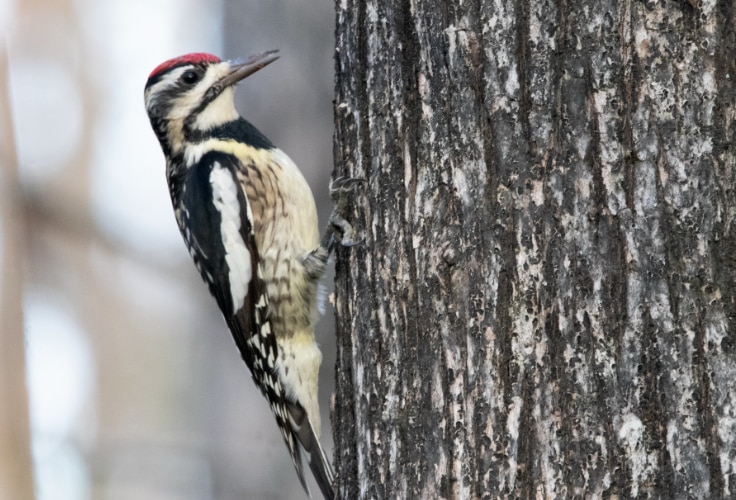
This species is found statewide during the non-breeding season, occurring in open forests, orchards, riparian edges, wooded neighborhoods, and larger yards with mature trees. It is fairly common in winter in all regions and often appears in mixed flocks with kinglets, nuthatches, and small songbirds. As temperatures warm, birds begin departing the state in early spring, leaving by late April or early May.
The yellow-bellied sapsucker remains stable across Alabama, its wintering populations supported by diverse habitats that offer live trees for sap drilling and sheltered foraging. Although sometimes overlooked due to its quiet behavior, it is a regular and dependable winter resident whose tidy grids of sap holes reveal a hidden but influential presence in the state’s cooler months.
Red-Cockaded Woodpecker
Leuconotopicus borealis
- Identification: Medium-sized black-and-white woodpecker with bold white cheek patches, barred back, and a narrow black malar stripe; males have a tiny red streak on each side of the head that is usually hidden.
- Where found: Rare and highly localized year-round in Alabama, restricted to mature, open pine forests, especially longleaf pine, primarily within the Talladega and Conecuh National Forests and a few other managed pine landscapes.
- How to spot: Look for a pale-cheeked woodpecker foraging high on mature pines; cavities often have fresh resin flowing below the entrance; listen for sharp “sklit” calls carrying through open pine stands.
- Conservation status: Near Threatened (IUCN); in Alabama, the species is of highest conservation concern and federally listed as Threatened, reliant on active habitat management and fire-maintained pine ecosystems.
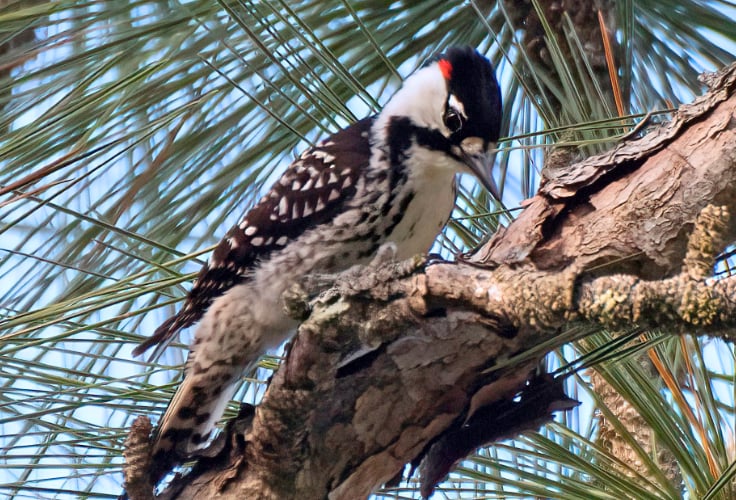
The red-cockaded woodpecker is one of Alabama’s most specialized and conservation-dependent birds, tied almost exclusively to mature, fire-maintained pine forests. Measuring 20 to 23 centimeters (7.9 to 9.1 inches) long, it is modest in size but distinctive, with a bold white cheek patch and finely barred upperparts. The tiny red “cockade” that gives the species its name is rarely visible in the field and is present only on adult males. Birds forage quietly on trunks and branches, scaling bark for insects and often remaining high in the canopy.
This is the only woodpecker in Alabama that excavates its cavities in living pine trees, typically those weakened by red heart fungus. Constructing these cavities can take several years, and birds maintain them with rings of fresh resin that deter climbing predators. The species lives in cooperative family groups consisting of a breeding pair and several helpers – usually offspring from previous years, that share in defending the territory and caring for young. The sharp, slurred “sklit” call is often the first clue to their presence.

In Alabama, red-cockaded woodpeckers occur only in landscapes with old, open pines and a grassy understory shaped by frequent fire. The state’s highest concentrations are found in the Oakmulgee District of Talladega National Forest, Conecuh National Forest, and smaller populations in the Mountain Longleaf National Wildlife Refuge and other managed pine tracts. They are nonmigratory and remain in their family territories throughout the year. Observers should search mature longleaf stands at dawn or late afternoon, when birds travel between foraging trees and cavity clusters.
Because their habitat once covered much of the Southeast but is now reduced to a small fraction of its historical extent, red-cockaded woodpeckers require ongoing conservation support. In Alabama, long-term recovery efforts include prescribed burning, retention of old pines, the installation of artificial nest cavities, and cooperative programs with private landowners. These measures have helped stabilize local populations, but the species remains rare and dependent on the persistence and restoration of the state’s remaining longleaf pine ecosystems.
Where to See Woodpeckers in Alabama
Alabama’s woodpeckers can be found statewide, but several landscapes offer especially good opportunities to observe the full diversity of species. Large forest tracts such as Bankhead National Forest, Talladega National Forest, and Conecuh National Forest support abundant populations of resident species, including pileated, red-bellied, downy, hairy, and red-headed woodpeckers. Open longleaf pine stands in the Oakmulgee District of Talladega and in Conecuh National Forest are the best places in the state to look for the rare and highly localized red-cockaded woodpecker, particularly at dawn and dusk when family groups move between cavity trees and foraging pines.
National wildlife refuges and protected river corridors also provide excellent viewing. Wheeler National Wildlife Refuge hosts strong numbers of common species year-round and is a reliable wintering area for yellow-bellied sapsuckers. The extensive bottomlands and mixed forests along the Mobile-Tensaw Delta, Bon Secour National Wildlife Refuge, and state parks such as Oak Mountain and Cheaha offer productive edges, snags, and foraging sites for multiple species, especially where water, mature timber, and open understory intersect.
Woodpeckers are most easily found by sound. Listening for drumming or for sharp contact calls is often more effective than scanning trunks directly. Trails with standing dead trees, fallen logs, or open pine structure are especially productive. With patience and attention to habitat, woodpeckers can be observed in nearly every region of Alabama, from upland hardwood ridges to coastal wetlands, making the state an excellent place to explore the diversity of this family year-round.



